Energy & refrigeration
Costco understands that the interrelationship between energy usage and refrigeration management is a key component to the reduction of our Scope 1 and 2 carbon emissions. As regulations change related to refrigerant types allowed for commercial use, efforts to install and/or upgrade our global refrigeration systems will continue to be a focal point.
Additionally, purchased electricity is the largest source of our Scope 2 carbon emissions and is also a significant annual expense. When we reduce our usage, we save expenses, which helps us to remain a low-cost operator and we reduce our emissions.
More information about our Scope 1 and 2 emissions can be found in our Climate Action Plan.
CONTINUOUS IMPROVEMENT THROUGH TECHNOLOGY & COLLABORATIVE LEARNING

We continue to use monitoring solutions and tools to identify energy consumption opportunities throughout our operations. To further enhance this effort we use the actionable data from these monitoring systems to equip our global operations with ways to identify opportunities to reduce energy consumption.
Costco continues to implement enhanced processes, procedures and energy management systems to aid in consumption awareness, engaging site staff in realizing operational energy system efficiencies and controls. In addition, Costco has rolled-out training and tools to support global site tracking and reporting of GHG carbon emissions source data.
Our process for emissions tracking includes a step-by-step reference guide (Global Carbon Emissions Reporting Guide) to support Costco-owned or leased sites, including: warehouses, business centers, depots, distribution facilities, delivery operations, manufacturing sites and offices. The process involves tracking of all Scope 1 sources at each location. Purchases for fuel, dry ice and CO2 (consumed) and/or refrigerant fills are tracked. These totals are then entered into Costco's emissions platform at each site.
In 2021, our U.S. Regional Environmental and Sustainability Compliance Managers continued to conduct Sustainability Technical Assistance Reviews (STARs), which assess operational efforts to engage in Costco's Sustainability programs, which includes reducing energy.
More information about the STAR can be found on our Environmental Compliance and Climate Action Plan pages.
We continue to improve the efficiency of refrigeration and HVAC systems by exploring and implementing new designs to maximize energy and water consumption efficiencies, while reducing potential for global warming as systems are considered for each site design application.
In order to stay abreast of regulatory changes and new technological advancements, Costco holds annual training sessions for our global Sustainability and Compliance teams. It is here that we share and learn about best practices, to increase awareness about the importance of climate change, and to learn how to reduce our carbon footprint and save energy, all of which in turn saves money.
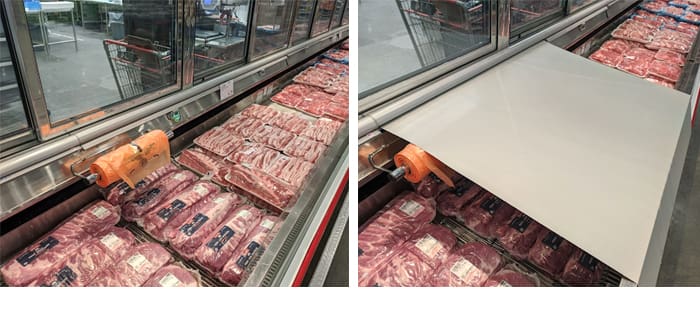
ENERGY-SAVING PROGRESS
Costco continues to implement improved systems and technologies in order to save energy and reduce our carbon footprint throughout our locations worldwide. Examples include:
- In 2020, U.S. locations began testing the use of display case shields (above photo) to reduce energy use. The shields are utilized during hours warehouses are closed to reduce power use while maintaining product temperature. As a result, there is less load on the refrigeration system with improved product temperature maintenance.
- Energy Management and Lighting Management Systems continue to be used globally to allow control of heating and cooling set points, lighting schedules, and system troubleshooting.
- Costco continues to enhance system tools and reporting to improve visibility to peak kwH consumption related to both lighting and refrigeration systems. As of 2020, new assessments for U.S. locations include a review of site peak consumption to identify and support maximizing energy efficiencies.
- Beginning in 2019, Mexico locations have used a new energy measurement project to provide real-time kwH consumption assessments. Through FY2021, the project identified energy saving opportunities in several locations to improve efficiency in refrigeration, HVAC and lighting. Given the success of the project, these measuring systems will be rolled out to additional locations.
- Locations in the UK have completed LED lighting conversions and have installed Voltage Optimization units at all locations to regulate/optimize incoming voltage which ensure operational efficiency.
- Locations in South Korea are equipped with centralized fire and energy monitoring and control systems. Other monitoring systems, including electrical, gas, refrigeration and elevator systems, are managed by a certified, on-site professional. As an example, the ventilation system and HVAC can be programmed or manually controlled by the centralized system relative to outside environments (temperature, humidity and wind) to maintain the optimal indoor atmosphere and refrigeration, and to maximize the energy conservation. Each location examines monthly energy consumption to identify opportunities to improve efficiencies, accordingly.
- Taiwan utilizes an operations energy management system to drive consumption efficiency through focused training and review of utilities (gas, electricity and water systems) usage and optimization measures.
- Iceland’s geothermal system produces hot water that provides space heating and hot water supplies throughout the location. In addition, this system facilitates snowmelt to free up sidewalks and key areas in front of the building, including the gas station forecourt (filling area) and the receiving (freight area) ramp.
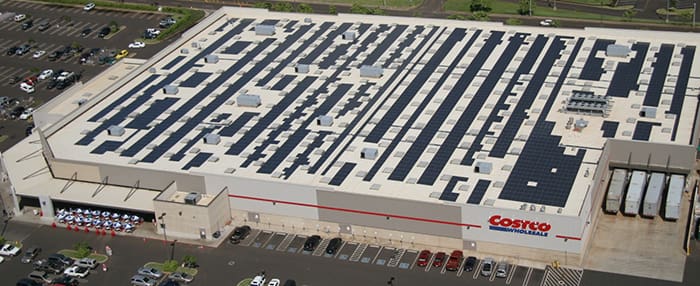
Solar Power
Costco continued to increase the number of locations with solar photovoltaic systems to 120 locations throughout the United States and in Spain, the UK, Taiwan, Japan and Australia as of the end of FY21. Additionally, some locations have implemented the use of solar power in the parking lots.
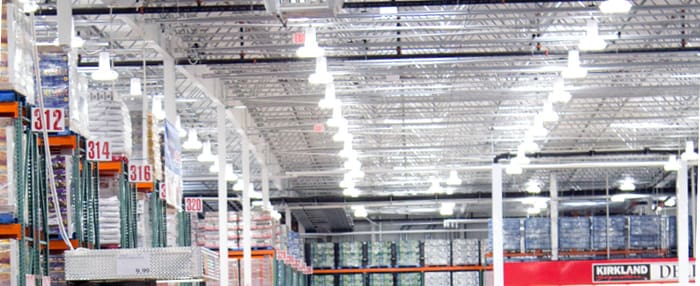
LIGHTING SYSTEMS
The conversion to LED ceiling lights in older U.S. buildings that began in 2016 continued in FY21 and is largely completed, with an estimated energy savings of over 235 million kWh per year. In addition, LED conversions continue throughout the company and include exterior lighting, ancillary departments, point-of-sale refrigerated boxes and gas stations. Lighting in new construction utilizes LED technology.
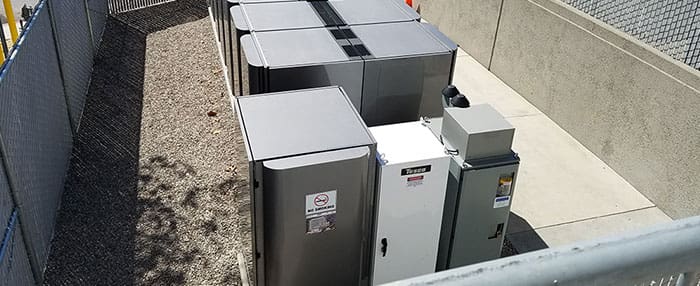
FUEL CELL TECHNOLOGY
In 2017, Costco began piloting the use of fuel cells as an additional source for generating on-site electricity. As of the end of FY21, we now have 12 locations in California powered in part by fuel cells that generate an estimated total of 62 million kWh of energy annually. To date Costco has found the following benefits:
- Lower demands on existing electric utility infrastructure
- Lower overall combined power and natural gas expenses
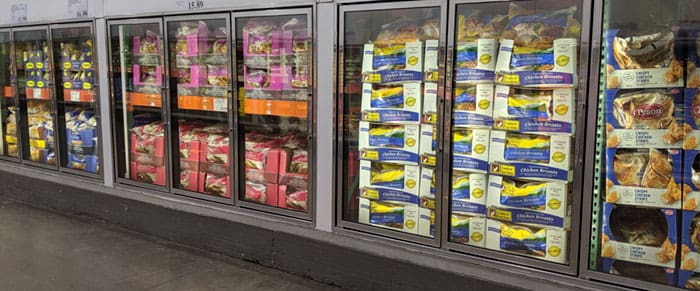
REFRIGERANT MANAGEMENT
Costco recognizes that refrigerants have a major impact on our climate. We continue to explore new refrigerant technologies and carefully select refrigerants that are low in Global Warming Potential (GWP) and reduce GHG emissions. We work with certified contractors who adhere to best management practices in the installation, maintenance and decommissioning of equipment and to control leaks impacting the environment.
We have a multifaceted plan to address energy and emissions that continues to expand as we learn more and as new governmental regulations are implemented. Additionally, as purchased electricity is our largest source of our operational cost contributing to emissions, we will seek operational efficiencies through the following ongoing efforts:
- Reviewing our cooling and heating systems with an approach to integrate them with our refrigeration systems for optimal performance
- Piloting various systems to detect refrigerant leaks
- Eliminating skylights in new construction and covering skylights in existing locations to lessen the workload of HVAC systems
- Purchasing renewable energy and/or installation of solar energy systems where feasible
- SOPs and employee trainings to address refrigeration maintenance and energy consumption
- Migrating to CO2 refrigerants where it is operationally viable and as of the end of FY21, CO2 is currently in use in select locations in the U.S., Canada, Spain, the UK, Iceland and Australia
- Equipping buildings with state-of-the-art leak detection systems to identify refrigerant leaks, and triggering system alerts to support more expedient leak detection for faster resolution
- Enhancing location-level collection of refrigerant leak data
- Considering systems for reducing potential for global warming for each site design application. An example of this would be in high ambient temperature climates, Costco has installed adiabatic systems that are hybrid systems and use an energy-efficient combination of fans and water to cool refrigeration systems throughout the day
- Working with certified contractors that adhere to best management practices in the installation, maintenance, and decommissioning of equipment, and to control leaks impacting the environment
- Installing new equipment in California with a capacity of 50 pounds or greater (22.7kg) required to use refrigerants with a GWP of less than 150. As a result, all new warehouses in California will use CO2 in their main refrigeration system
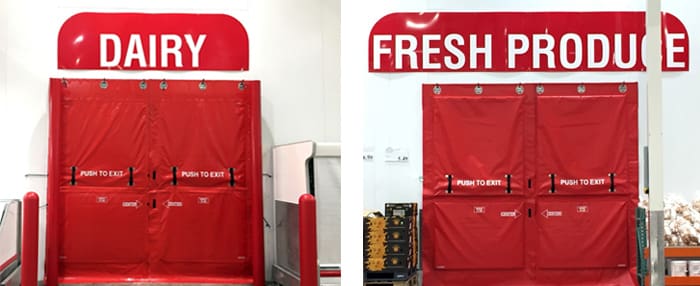
- Installing insulated doors to the walk-in refrigeration point of sale coolers in our U.S. and Mexico locations, which are closed when we are not open. These doors allow point-of-sale coolers to maintain temperature more easily while putting less stress on the refrigeration system. While we originally estimated annual savings of 95,000 kWh per location, we learned that after analyzing our data for insulated doors in place for at least a year, the actual savings are 25,000 to 35,000 kWh per location. Given these continued savings, we will continue to add the insulated doors in our new locations and remodels when appropriate.